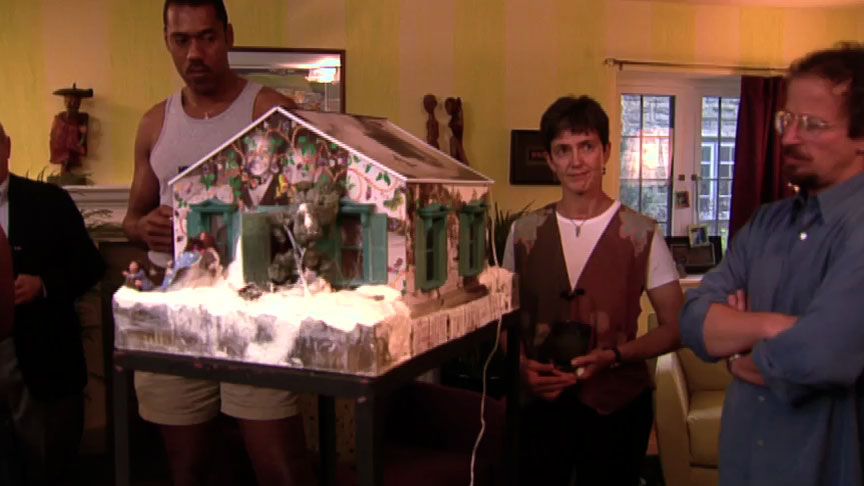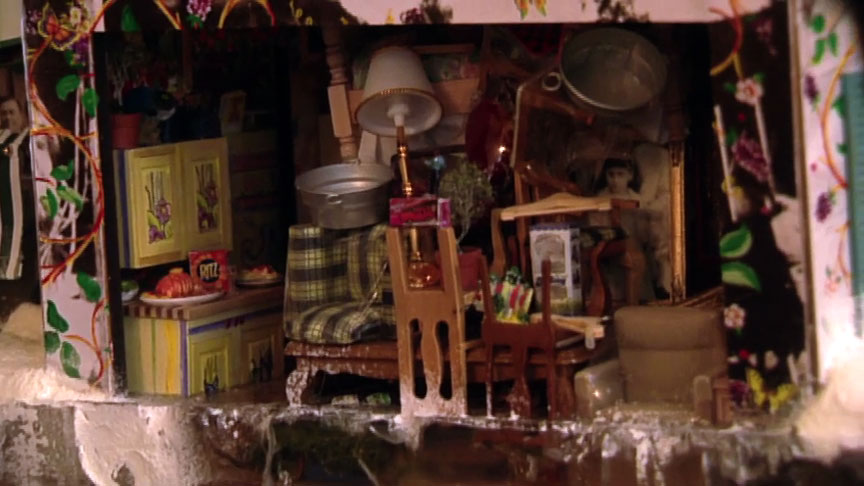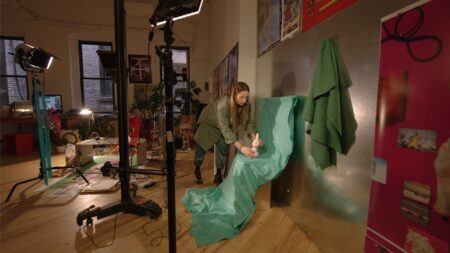Interview
“Home Visits”

Pepón Osorio visits the residence of a Home Visit (1999-2000) host in Puerto Rico, 2000. Production still from the Art in the Twenty-First Century Season 1 episode, Place. © Art21, Inc. 2001.
Pepón Osorio discusses his Home Visits, instances in which a new family lives with an artwork for a period of time, allowing the story of each piece to be told in many homes and environments.
ART21: How did the work Home Visits come about? Could you describe your process?
OSORIO: Home Visit came about as I started to notice that it’s not enough for the work to be in a museum, or to be in a storefront. And also when I start thinking about possessions, about collectors—what does that mean? How do people collect? These pieces that people have in their homes are so valuable to them, and somehow all of a sudden they lose them, all due to a dispossession, or lose them all to fire, stolen, or whatever occasion or event might have occurred. And so, then I’m starting to worry about things like that. And I’m thinking that people in Venezuela just had tremendous floods, and they’ve lost families, and I start thinking of images of camps full of children that don’t know where their parents have gone or whatever happened to them. Then I think of Bosnia, and I think of Rwanda, and I think about how in some places there’s so much; and all of a sudden, you just lose it all overnight and you have to move on.
And so, I think of ways of connecting, and how my work can connect to those experiences, but also to the idea of displacement and the idea of how you move from one place to another. And the images don’t necessarily come to me right away. I don’t think of images; I am thinking of events and of circumstances more than anything else. And then in Home Visit, I started to think, “Well, you know, what if I lose it all? Whatever happens to me? What could happen to me?” It’s a starting point to look at how any specific population deals with these issues. And I decided that I wanted to work with someone who had just lost it all, somehow. I got in touch with a group in Philadelphia. Home Visit is my first piece in my new home, Philadelphia. And I started to talk to the people in Congreso, which is an organization, a Latino organization in Philadelphia, about the possibility of meeting someone who had just lost it all. I was intrigued by the idea that I’ve gained so much, yet the possibility of losing it all overnight . . .
And they connected me with this mother and her two daughters; her name is Tina. We started to talk, with the understanding that at some point, I will create a work of art in the process of it but that I will involve them, the three of them, in the process of it. And we sat for about a month, talking. I would occasionally call them up and show up at their home, and we will talk about that until I felt that it was okay to start talking about the event, when the fire occurred. They lost everything in a fire. And we talked about that. And we cried together. It’s a lot of tears in my work, I realized. And then I thought, “Well, why don’t I recreate that home? Why don’t we go back to the event and do kind of a drill?” And they were willing, scared; I was scared. And we sat and remembered, in the dining room. We sat, and I placed the objects in the house with all the different objects that go in the house. And I told them, “You’ll have two minutes to walk out the door in that little house. What will you take with you?” And then they started grabbing different objects. “And well, if I give you about an hour and a half, what would you do? You have to pile them up, to make sure that you secure them.” So, they piled them up.

Detail of Tina’s House installed at the residence of a Home Visit (1999-2000) host in Puerto Rico, 2000. Production still from the Art in the Twenty-First Century Season 1 episode, Place. © Art21, Inc. 2001.
But little stories, the deepest story started to come out in the process of it. And that’s when I started hearing, little by little, about the different moments and the circumstances of what was lost, and I included that in the work. The resin, which looks like that block, that plastic block around the home—I was told that it was in the middle of winter when it happened. So, when the firemen came in, everything turned into ice. It froze, and I thought that was a metaphor: to freeze our possessions, to hold our possessions. And that’s what that image comes out of. The only thing that the mother can think of was saving the children, so then she’s outside with the children.
I use photography in my work as a way of balancing things off. So, I started to do research for this piece, and I found a photograph from the turn of the [nineteenth to the twentieth] century. And this piece was created in the year 2000, so it was also the turn of another century. And I used both photographs—the one created in 1899–1900 and the one from 1999–2000, and I placed them together—of a very familiar circumstance, or a very similar circumstance that had happened. There is a woman in a sugar cane plantation, and there is Tina in Philadelphia, and I placed them both together.
I was also looking for a home, so I placed myself on the roof. And there are a lot of details, personal details that are related to it. I think the very personal becomes universal in that sense, because I think that the concept, the ideas, the intentions that I have are a universal language and connect to many different people at many different levels. And that’s how I come to create work from the very specific. What in a general public will be the least important event in their life becomes a significant work of art that has tremendous resonance in a larger public.
ART21: The story of how the work came about seems to be such an integral part of the work. Do you consider yourself a storyteller?
OSORIO: I don’t consider myself a storyteller. I think of it more as what I have to say. It’s almost like when you think that you have this personal problem, and then you join a group, and then all of a sudden everybody has the same problem you have, and you feel like, “Oh I don’t have a problem, then.” That’s what I think. I think that what I have to say is important to say, because somehow it demystifies, dismisses, this whole idea that it’s so crucial. But at the same time, I feel that every time I create a work of art, I’m trying to say something in order to release that core, in order to let that core move through our community and allow the people to talk and reflect back on what I have to say. It’s not that I’m telling a story; it’s that I’m allowing others to tell their own stories as I come in, showing the work. It’s group therapy. (LAUGHS) Just kidding.

Detail of Tina’s House installed at the residence of a Home Visit (1999-2000) host in Puerto Rico, 2000. Production still from the Art in the Twenty-First Century Season 1 episode, Place. © Art21, Inc. 2001.
ART21: Why does the work travel to so many locations? Is this part of the idea of sharing stories?
OSORIO: Home Visits is rooted in a very religious tradition in Latin America and Puerto Rico, in a religious popular tradition of the visiting saint. When I was a kid, we were visited by the image of a Virgin of Guadeloupe—sent by the church, I’m sure, to collect money; but anyway, sent by the church—and it came to our home, once every two months. And around that neighborhood, to many of the different families, it just visited; it went from one house to another.
It was very interesting because, for me, it was a big celebration. I remember: every time the Virgin of Guadeloupe came to the home, it was to be a big celebration, in the sense of finding a place for it to be. (The lady who brought it, who was in charge of moving it from one place to another, had a great conversation with my mother; they would have coffee, and I would be drinking juice.) A big celebration in a sense of high energy—not a big celebration of an opening, in a sense, but of high energy. And that Virgin went from one home to another for as much as I can remember. I was probably twenty-five, and it was still going from one place to another. And I thought, “What about the same thing with contemporary art? Why can’t contemporary art visit one home after the other for the week?”
And, I was interested in restoring faith at some point. I felt that, somehow, that moving to Philadelphia, the community in Philadelphia—I needed it to restore my faith. Somehow, coming to terms with the idea of living in a place for twenty-five years—I’d been in New York City, and then I just moved to Philadelphia—I needed to somehow believe that it was going to be okay. And what a clever way to do it, (LAUGHS) to have Home Visit going from one home to another, and visiting different places and getting to know all the people. And I just thought, “Well, this is the right thing to do.” And all of a sudden, I just realized, “Maybe the best thing to do is to do it nationally.”
If I wanted to challenge myself, the greatest challenge will be to go from one state to another state. And that’s how it came to be a piece that doesn’t stay in one place. It’s created in different levels. One level is about losing your immediate possessions. On another level, it’s about restoring faith, which is what happens immediately after you lose something. And simultaneously, it’s about possessing contemporary art, and how a work of contemporary art can take a major space in your home.
And, going back to the studies that I’ve mentioned before, at a very high level—because it’s on a stand, it really radiates and has a prime, aerial space in your living room or dining room, wherever you want to place it. And at the same time, you’ll have the communication. It’s about welcoming but also about saying good-bye. And it’s about the connection that you have to the work of contemporary art: as it comes to your home, you welcome it, you live with it for a week, and then you have to move it on, in faith, that it will be well taken care of, wherever it goes.



